

Clive Sinclair and the Pocket calculator

© 2003 & 2021 Nigel Tout
This is a new article which was not originally in "The International Calculator Collector".
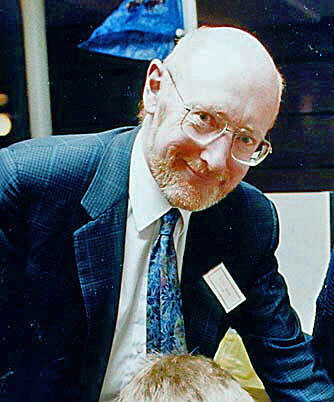
Clive Sinclair (1940-2021) in 1992.
Photo from Wikimedia, author Arpingstone
The Sinclair Executive
For people in Britain in the 1970s and 1980s Clive Sinclair was known as "the inventor of the pocket calculator".
Although not really true (it depends on the size of your pocket), Sinclair stunned the world in the summer of 1972 when he launched his first electronic calculator, the Executive, which was smaller and considerably thinner than any other on the market. The vital statistics of the Sinclair Executive are 56mm x 138mm x 9mm / 2.2" x 5.4" x 0.35" and it fits easily into a shirt pocket without making a bulge.
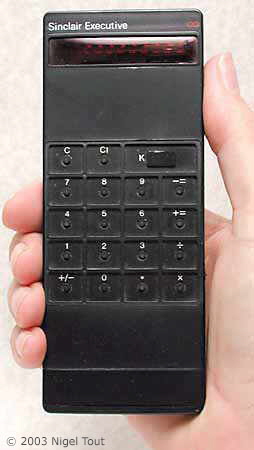
The first Sinclair calculator, the Executive.

Side view showing how thin the Executive is.
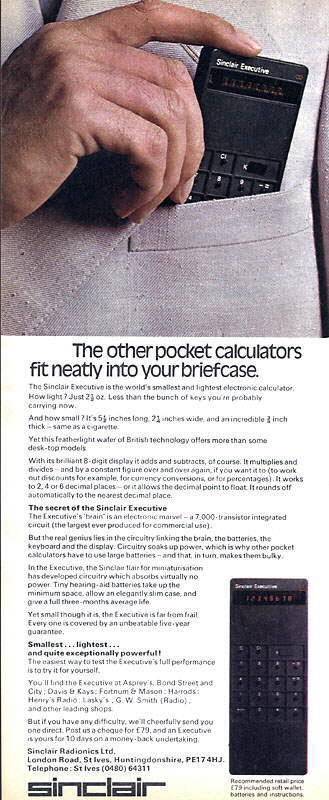
Clive Sinclair was an electronics genius and is noted for his miniature electronic products achieved by using very innovative designs. The first Sinclair Executive calculators used one of the standard calculator chips of the time, the Texas Instruments TMS1802. This normally has a current consumption of about 300 mA which dictates that normal AA size batteries, or larger, need to be used to give a decent battery life.
Sinclair in his quest for miniaturisation, to produce a true pocket calculator, wanted to use button cells rather than normal batteries, but these would be drained in minutes by the chip and the LED display. However, Chris Curry and Jim Westwood at Sinclair Radionics, in Huntingdon, England, found that the power to the chip did not have to be on continuously, it could be pulsed and the internal capacitance of the chip would store enough electrical charge to keep it working till the next power pulse. Power pulses lasting 1.7 microseconds are used, at a frequency of 200 KHz during calculations and 15KHz between each operation, reducing the power consumption to 25 to 30 mW. Texas Instruments did not recommend operating in this way, but it allows the Executive to get about 20 hours continuous operation from 3 small mercury button cells.
The unusual, Sinclair designed keyboard also contributes to the small size of the Executive, with the little rubber pips which press directly on the beryllium-copper contacts.
There is much more information about the Sinclair Executive in the Featured Hand-held Calculators section.
Early days of Sinclair innovation
Born in 1940, Clive became intensely interested in mathematics and electronics at school, and designed his own electronic
circuits. While at school he wrote his first article for the magazine Practical Wireless which was published, and he went for holiday jobs in electronic companies.
Clive left school just before his eighteenth birthday. Although he could have gone to university, he did not, reckoning that he could find out anything that he wanted to know by himself. Clive's father was a business man, and Clive showed the same business flair. While at school he had drawn up details in an exercise book of the Sinclair Micro Radio Kit, complete with costings to the last detail, including postage and packing. He realised that electronic components were very cheap if bought in thousands, and that large advertisements in the hobby electronics magazines would be eye-catching and bring in orders.
Fortunately, the magazine Practical Wireless advertised for an editorial assistant, which Clive applied for and got. Shortly afterwards, in 1958, Bernard Babani enticed Clive away to run his technical publishing company, where Clive also wrote thirteen contructor's books by 1962.
Clive still had ambitions to form his own company, and had registered the company Sinclair Radionics in 1961. Having found financial backing he left Babani's, only to have the backer get cold feet and withdraw. Clive then got a job as technical editor with the journal Instrument Practice, for which he also wrote articles. One of his tasks was to produce a comprehensive survey of the available semiconductors, which opened the door for him at all the semiconductor manufacturers.
At one of the manufacturers, Clive discovered that there were tens of thousands of transistors available very cheaply because they were outside the manufacturer's published specification. However, this did not make them useless, so Clive bought them up, tested them, re-named them, and sold them together with designs for their use.
In late 1962 the first advertisements from Sinclair Radionics for a Micro-amplifier kit appeared. The Sinclair Radionics office, with research, development, and marketing, was in Cambridge, with the kits being produced and despatched nearby by Cambridge Consultants Ltd., a contract research and development company. The Micro-amplifier was followed by the Sinclair Slimline micro radio, the smallest radio on the market at 2.75" x 1.625" x 0.625" (70 x 41 x 16 mm).
This was to be the pattern of Sinclair's electronics business. The products were miniaturised and highly innovative; the advertisements for them were large and eye-catching; they were sold by mail order, generally as kits; and they were competitively priced.
Unfortunately, the down side to this business model was soon discovered. If a new product was very attractive, so many orders were received that production was overwhelmed and there were long delays in sending them out. This was to be a recurring problem for Sinclair, as also was poor quality control in the rush to meet orders. To mitigate this was the Sinclair policy of exchanging faulty items immediately with no questions asked.
Sinclair Radionics followed up with further very innovative amplifiers, micro radios, and hi-fi units for the hobbyist, which were sold through stores as well as by mail order. Another innovation, "Sinclair News" started to be produced in 1964, with information about Sinclair Radionics and its products.
Sinclair Radionics was very successful, and in 1970, due to the needs for space, moved into part of an old flour mill in St. Ives, then in Huntingdonshire, alongside another electronics company.
Calculators
In 1972 the Sinclair moved into pocket calculators with the Executive, as outlined above, and also the first Sinclair portable digital
multimeter was launched.
Sinclair had shown what could be done with miniaturising calculators, and the competition would soon start to follow, so he had to keep an innovative lead.
The Cambridge series of calculators followed the Executive, with the first model being launched in 1973.
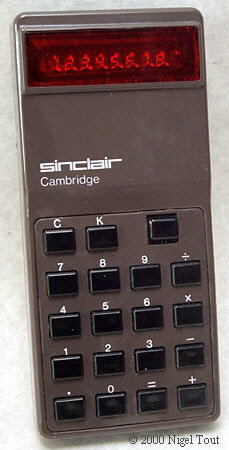
The first of the Sinclair Cambridge range.
The Sinclair Cambridge range were all based on the same small, pleasingly rounded shape which could easily fit in the pocket. Most used AAA pen cell batteries, but some later models were spoilt be requiring a thick 9v PP3 battery, which required a "pregnant" bulge on the back.
The Sinclair business philosophy was to research and design its products itself but to sub-contract manufacture. In this way it could respond quickly to market changes. However, this makes modification of the design tricky and quality control more difficult, which caused problems with the thousands of calculators now being exported, and being sold to non-hobbyists. In 1973, Sinclair set up its first quality control department to address this problem.
Following on from the ingenious use of an existing calculator chip in the Executive, to minimise power consumption, Sinclair managed to produce a scientific calculator using a cheap non-scientific calculator chip. The first hand-held scientific calculator, the Hewlett Packard HP-35, had been launched in early 1972, but was expensive, and Clive wanted to compete with this.
The Texas Instruments "calculator-on-a-chip" integrated circuits had the possibility of having their operating instructions altered by using different masks in the manufacturing process. Nigel Searle, at Sinclair Radionics, managed to implement scientific algorithms on the standard Texas Instruments TMS0805 chip to give a low-cost scientific calculator, though with a lower specification than the HP-35.
There is more information about the Sinclair Scientific in the Featured Hand-held Calculators section.
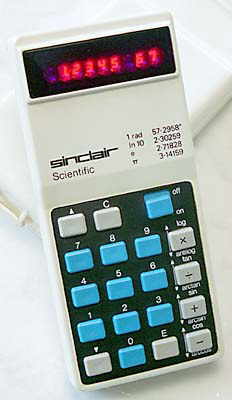
The Sinclair Scientific low cost scientific calculator.
The Sinclair Scientific provides the basic trigonometric functions and log/antilog. It uses Reverse Polish Notation (RPN) like the HP-35, and gives results in scientific notation. Like many Sinclair calculators it was available even cheaper as a self assembly kit.
In 1974 Sinclair produced a design for Gillette, since the shaver manufacturer had decided to diversify into consumer electronics. The result was the Gillette GPA calculator, which was sold for a short period before Gillette reversed its decision on moving into calculators.
In March 1975 'The Times' reported[2]:
" The former technical journalist who set up Sinclair Radionics in 1962 to sell radio kits to enthusiasts has
since continued his innovations with success. In 1973-74 the company's sales exceeded £4m; the estimate for 1974-75 is £7m.
Calculators now account for between 80 and 90 per cent of this business. The
first appeared in June 1972, and the millionth was produced this month. Production is approaching 100,000 a month, with more than 55 per cent for export.
From its headquarters in a converted millhouse
overlooking the river Ouse at St Ives in Huntingdonshire, Sinclair Radionics subcontracts most of the assembly work to outside companies. It buys in all the components and tests all the assembled machines.
"I
still spend most of my time on the engineering side", Mr Sinclair says. One of his directors, Mr Nigel Searle, is now based permanently in the United States (there is an associated company there and another in Germany);
assembly of calculators for the Far East market has begun on a trial basis in Singapore; and almost 100,000 calculators have been supplied to Gillette for a test-marketing exercise in the United States.
With its
pocket calculators well established (and much copied) in world markets, Sinclair is introducing the Oxford range of slightly larger mains-battery machines. For Mr Sinclair, continued innovation in new designs and more
automated production is the aim."
Sinclair used the Gillette GPA as the basis for its Oxford range, launched in 1975.
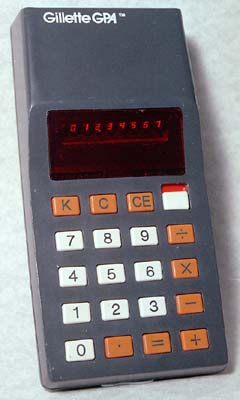
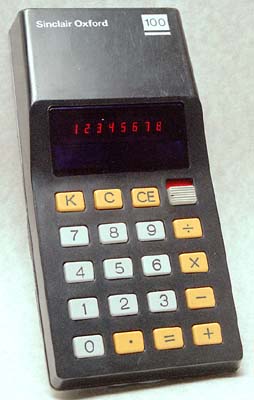
Gillette GPA.
Sinclair Oxford 100.
The Sinclair Oxford range comprised several models, with the early ones having LED displays. Later a change was made to the lower power consumption green VFDs (Vacuum Fluorescent Displays), and the case was made more rounded as shown in the photograph below.
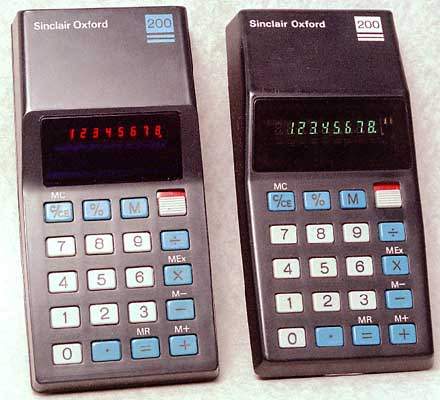
Earlier Sinclair Oxford 200 with red LED display, on the left , and later version with green VFD (Vacuum Fluorescent Display) and more rounded casing, on the right.
The pocket calculator had been a great success for Sinclair, but by the late 1970s the calculator line was starting to feel the effects of small, cheap, highly reliable calculators from Japan. Sinclair had also decided to stick with LED and VFD displays, whereas Japanese manufacturers were starting to shift to LCDs (Liquid Crystal Displays), which had very low power consumption and batteries lasted for months.
Sinclair produced a few more models, including the cheap programmable Enterprise Programmable. Like all the Sinclair programmable models, it was provided with comprehensive manuals with sample programs in different subjects.
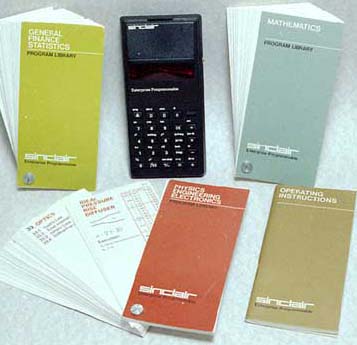
Sinclair Enterprise Programmable and programming manuals.
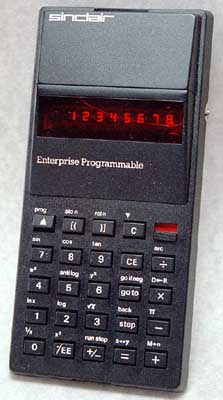
The elegant Sinclair Sovereign, designed by John Pemberton, received a major design award and was a move upmarket. Available in black and polished chrome, a gold finish version was produced, and to commemorate the Silver Jubilee (25 years) of the reign of Queen Elizabeth II in 1977 there was a limited-edition silver plated version.
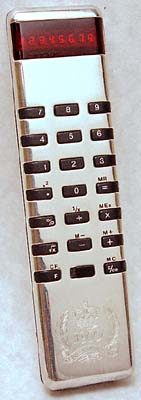
Limited edition "silver jubilee" Sinclair Sovereign.
Miniature TVs, troubles, computers
While all the developments with the calculators had been taking place a lot of other things had been happening at Sinclair
Radionics. With his interest in miniaturising electronics it was natural that Clive would look into developing a miniature television. This had started in the early 1960s and a Microvision was exhibited in 1966. However, the problems were enormous - finding a source of small TV tubes; the high power consumption; the high voltages; the complexity - and it never went into production.
The pursuit of the dream of the hand-held television was to consume an awful lot of time, effort, and money at Sinclair Radionics. It was not until ten years later, in 1976, that the Sinclair TV1A Microvision was launched. Although only a black & white model, it was revolutionary in being the first multi-standard receiver, working on VHF and UHF, and so could be used around the world. Clive's ultimate idea was a flat screen TV and work continued on developing a near flat television tube.
The cost of developing the TV had been very high and the calculator business was now unprofitable. There were high hopes of the Sinclair Black Watch, an LED digital watch in a futuristic black plastic casing. But there were problems with the semiconductor manufacturers and the company producing the plastic mouldings, resulting in it being about two years late. By this time digital watches were starting to use LCDs which display continuously, and there were major quality and battery life problems, so the Black Watch flopped.
Clive Sinclair had a deserved reputation of being a very innovative entrepreneur, but by the end of 1976 Sinclair Radionics was in financial difficulties. The British government's National Enterprise Board (NEB) bought heavily into Sinclair Radionics, and was especially interested in the flat screen television which might rejuvenate the ailing UK television industry.
However, the financial situation did not get any better. The NEB gave further heavy financial help but was under pressure not to lose the taxpayer's money, so they tried to raise money by selling off assets. The calculators were no longer profitable, so in 1979 the rights to the Radionics name, together with parts and dies, were sold to the ESL Bristol group of companies under the name Radionics Products Ltd. The NEB also sold the television business to Binatone, but retained the Sinclair instruments division which was later taken over and became Thandar.
While Sinclair Radionics was collapsing under the NEB, Chris Curry and Clive Sinclair had been discussing alternatives which resulted in them starting another company, Sinclair Instruments Ltd. It launched its first product, the Sinclair Wrist Calculator, which made use of redundant calculator electronics components, and changed its name to Science of Cambridge.
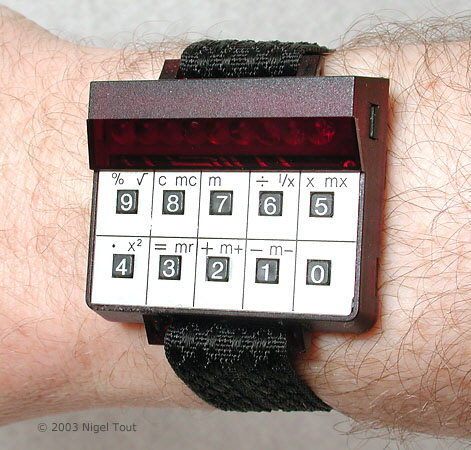
Sinclair Wrist Calculator.
Although the Wrist Calculator sold reasonably well it had the old Sinclair problem of poor quality control.
The wrist calculator was the last of the line of calculators that were developed under Clive Sinclair. The dates of introduction of some of his notable calculator models are listed below. All are from Sinclair Radionics Ltd., except where noted[3]:
- June 1972 - Sinclair Executive - there are two versions of the Executive.
- August 1973 - the first Cambridge model. There are nearly a dozen Cambridge models, ranging from simple 4-function machines to the Cambridge Programmable.
- November 1973 - Sinclair Executive Memory.
- April 1974 - Sinclair Scientific. This used the casing of the Cambridge models.
- March 1975 - Sinclair Oxford models. Initially there were 3 models, the 100, 200, and 300 with LED displays. Later versions had VFD displays, and other Oxford models followed.
- August 1975 - Sinclair Scientific Programmable.
- Late-1976 - Sinclair Sovereign model.
- February 1977 - Sinclair Cambridge Scientific.
- February 1977 - Sinclair Wrist Calculator (from Sinclair Instruments Ltd.).
- October 1977 - Sinclair Enterprise.
- February 1978 - Sinclair President.
- July 1978 - Sinclair Enterprise Programmable.
Fortunately, microprocessors were now becoming common items, and Chris Curry remembered that Ian Williamson, a young electronics engineer, had produced a design for a microprocessor hobbyists kit. Although Clive was not very enthusiastic, this was developed further, and sold as the Science of Cambridge MK14 (Microcomputer Kit 14), though comprising of little more than circuit board with electronics, 8-digit LED display, calculator type keyboard, and instructions of how to use it.
However, Chris Curry was fed up with Clive and his lack of enthusiasm for the MK14, so he left Science of Cambridge, and started up Acorn Computers to develop the MK14 concept further.
At this time developments in microprocessors, "the computer on a chip", were newsworthy and the MK14 sold well to those wanting to find out more. Clive realised the potential, and developments continued, soon leading to the Sinclair ZX80, the world's smallest and cheapest computer, being launched in 1980.
The ZX80 was highly successful, and was followed by a series of improved models. However, the old Sinclair problems of being unable to meet high demand and quality control took their toll, especially with the Sinclair QL home computer.
In 1984 Sinclair finally launched a flat screen TV which was moderately successful, but by now there were competitors around in the hand-held TV market.
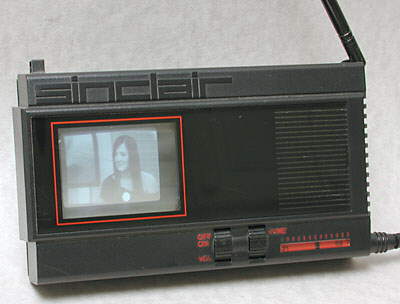
The Sinclair flat-screen pocket-sized television which cost such a lot to develop.
The screen is actually a cathode ray tube with the electron beam coming from the side.
Sinclair's last high-profile product was the C5 electric tricycle, launched in 1985. This was a valiant design for a very environmetally friendly, low-slung, streamlined, electric vehicle. However, it was not very practical in traffic and sales were poor before it was discontinued.
Since then, Sir Clive, as he was honoured, has maintained a low profile, and sadly very little has appeared under the Sinclair name. Sinclair products have a good following among collectors, where the innovative designs which make them stand out from the others are greatly appreciated.
For further information about Sinclair calculators and more photographs see the Sinclair Calculators section on the associated Vintage British calculators site.
Richard Torrens has produced the website Sinclair Radionics: an Inside View 1964 - 1975 with details of his time with Clive Sinclair from 1964-1975. Although mainly concerned with Sinclair audio equipment this site gives an extremely interesting insight into one of the most innovative electronics companies of the time, and is thoroughly recommended.
Sources of information:
- Dale, R., (1985), "The Sinclair Story", London, Duckworth, ISBN 0 7156 1901 2.
- Milton, Richard, "Rapid changes bring large companies their opportunity", The Times, March 24, 1975.
- Adamson, I., and Kennedy, R., (1996) "Sinclair and the 'Sunrise' Technology", Harmondsworth, Penguin Books Ltd., ISBN 0-14-008774-5.
- "Electronics" magazine.
- "New Scientist" magazine.
Calculator Articles
Vintage Calculators
Text & photographs copyright, except where stated otherwise, © Nigel Tout 2000-2026.